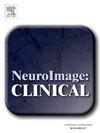Detection of structural-functional coupling abnormalities using multimodal brain networks in Alzheimer’s disease: A comparison of three computational models
IF 3.6
2区 医学
Q2 NEUROIMAGING
引用次数: 0
Abstract
Alzheimer’s disease (AD) is a progressive neurodegenerative disorder characterized by the disconnection of white matter fibers and disrupted functional connectivity of gray matter; however, the pathological mechanisms linking structural and functional changes remain unclear. This study aimed to explore the interaction between the structural and functional brain network in AD using advanced structural–functional coupling (S-F coupling) models to assess whether these changes correlate with cognitive function, Aβ deposition levels, and gene expression. In this study, we utilized multimodal magnetic resonance imaging data from 41 individuals with AD, 112 individuals with mild cognitive impairment, and 102 healthy controls to explore these mechanisms. We applied different computational models to examine the changes in the S-F coupling associated with AD. Our results showed that the communication and graph harmonic models demonstrated greater heterogeneity and were more sensitive than the statistical models in detecting AD-related pathological changes. In addition, S-F coupling increases with AD progression at the global, subnetwork, and regional node levels, especially in the medial prefrontal and anterior cingulate cortices. The S-F coupling of these regions also partially mediated cognitive decline and Aβ deposition. Furthermore, gene enrichment analysis revealed that changes in S-F coupling were strongly associated with the regulation of cellular catabolic processes. This study advances our understanding of the interaction between structural and functional connectivity and highlights the importance of S-F coupling in elucidating the neural mechanisms underlying cognitive decline in AD.
在阿尔茨海默病中使用多模态脑网络检测结构-功能耦合异常:三种计算模型的比较
阿尔茨海默病(AD)是一种进行性神经退行性疾病,其特征是白质纤维断开和灰质功能连接中断;然而,连接结构和功能变化的病理机制仍不清楚。本研究旨在利用先进的结构-功能耦合(S-F耦合)模型,探讨AD中结构和功能脑网络之间的相互作用,以评估这些变化是否与认知功能、Aβ沉积水平和基因表达相关。在这项研究中,我们利用41名AD患者、112名轻度认知障碍患者和102名健康对照者的多模态磁共振成像数据来探索这些机制。我们应用不同的计算模型来研究与AD相关的S-F耦合的变化。我们的研究结果表明,通信和图调和模型在检测ad相关病理变化方面表现出更大的异质性,并且比统计模型更敏感。此外,S-F耦合随着AD在全局、子网络和区域节点水平的进展而增加,特别是在内侧前额叶和前扣带皮层。这些区域的S-F偶联也部分介导了认知能力下降和Aβ沉积。此外,基因富集分析表明,S-F偶联的变化与细胞分解代谢过程的调节密切相关。这项研究促进了我们对结构和功能连接之间相互作用的理解,并强调了S-F耦合在阐明AD认知能力下降的神经机制中的重要性。
本文章由计算机程序翻译,如有差异,请以英文原文为准。
求助全文
约1分钟内获得全文
求助全文
来源期刊

Neuroimage-Clinical
NEUROIMAGING-
CiteScore
7.50
自引率
4.80%
发文量
368
审稿时长
52 days
期刊介绍:
NeuroImage: Clinical, a journal of diseases, disorders and syndromes involving the Nervous System, provides a vehicle for communicating important advances in the study of abnormal structure-function relationships of the human nervous system based on imaging.
The focus of NeuroImage: Clinical is on defining changes to the brain associated with primary neurologic and psychiatric diseases and disorders of the nervous system as well as behavioral syndromes and developmental conditions. The main criterion for judging papers is the extent of scientific advancement in the understanding of the pathophysiologic mechanisms of diseases and disorders, in identification of functional models that link clinical signs and symptoms with brain function and in the creation of image based tools applicable to a broad range of clinical needs including diagnosis, monitoring and tracking of illness, predicting therapeutic response and development of new treatments. Papers dealing with structure and function in animal models will also be considered if they reveal mechanisms that can be readily translated to human conditions.
 求助内容:
求助内容: 应助结果提醒方式:
应助结果提醒方式:


